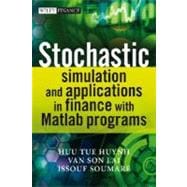
What is included with this book?
VAN SON LAI is Professor of Finance at the Business School of Laval University, Canada. He obtained his Ph.D. in Finance from the University of Georgia, USA and a master degree in water resources engineering from the University of British Columbia, Canada. He is also a CFA charterholder from the CFA Institute and a registered P.Eng. in the Province of British Columbia. An established teacher and researcher in banking, financial engineering, and risk management, he has extensively published in mainstream banking, economics, and finance journals.
ISSOUF SOUMARÉ is currently associate professor of finance and managing director of the Laboratory for Financial Engineering at Laval University. His research and teaching interests included risk management, financial engineering and numerical methods in finance. He has published his theoretical and applied finance works in economics and finance journals. Dr Soumaré holds a PhD in Finance from the University of British Columbia, Canada, MSc in Financial Engineering from Laval University, Canada, MSc in Statistics and Quantitative Economics and MSc and BSc in Applied Mathematics from Ivory Coast. He is also a certified Professional Risk Manager (PRM) of the Professional Risk Managers’ International Association (PRMIA).
| Contents | |
| Preface | |
| Introduction to Probability | |
| Intuitive Explanation | |
| Axiomatic Definition | |
| Introduction to Random Variables | |
| Random Variables | |
| Random Vectors | |
| Transformation of Random Variables | |
| Transformation of Random Vectors | |
| Approximation of the Standard Normal Cumulative Distribution Function | |
| Random Sequences | |
| Sum of Independent Random Variables | |
| Law of Large Numbers | |
| Central Limit Theorem | |
| Convergence of Sequences of Random Variables | |
| Introduction to Computer Simulation of Random Variables | |
| Uniform Random Variable Generator | |
| Generating Discrete Random Variables | |
| Simulation of Continuous Random Variables | |
| Simulation of Random Vectors | |
| Acceptance-Rejection Method | |
| Markov Chain Monte Carlo Method (MCMC) | |
| Foundations of Monte Carlo Simulations | |
| Basic Idea | |
| Introduction to the Concept of Precision | |
| Quality of Monte Carlo Simulations Results | |
| Improvement of the Quality of Monte Carlo Simulations or Variance Reduction Techniques | |
| Application Cases of Random Variables Simulations | |
| Fundamentals of Quasi Monte Carlo (QMC) Simulations | |
| Van Der Corput Sequence (Basic Sequence) | |
| Halton Sequence | |
| Faure Sequence | |
| Sobol Sequence | |
| Latin Hypercube Sampling | |
| Comparison of the Different Sequences | |
| Introduction to Random Processes | |
| Characterization | |
| Notion of Continuity, Differentiability and Integrability | |
| Examples of Random Processes | |
| Solution of Stochastic Differential Equations | |
| Introduction to Stochastic Calculus | |
| Introduction to Stochastic Differential Equations | |
| Introduction to Stochastic Processes with Jump | |
| Numerical Solutions of some Stochastic Differential Equations (SDE) | |
| Application case: Generation of a Stochastic Differential Equation using the Euler and Milstein Schemes | |
| Application Case: Simulation of a Stochastic Differential Equation with Control and Antithetic Variables | |
| Application Case: Generation of a Stochastic Differential Equation with Jumps | |
| General Approach to the Valuation of Contingent Claims | |
| The Cox, Ross and Rubinstein (1979) Binomial Model of Option Pricing | |
| Black and Scholes (1973) and Merton (1973) Option Pricing Model | |
| Derivation of the Black-Scholes Formula using the Risk-Neutral Valuation Principle | |
| Pricing Options using Monte Carlo Simulations | |
| Plain Vanilla Options: European put and Call | |
| American options | |
| Asian options | |
| Barrier options | |
| Estimation Methods for the Sensitivity Coefficients or Greeks | |
| Term Structure of Interest Rates and Interest Rate Derivatives | |
| General Approach and the Vasicek (1977) Model | |
| The General Equilibrium Approach: The Cox, Ingersoll and Ross (CIR, 1985) model | |
| The Affine Model of the Term Structure | |
| Market Models | |
| Credit Risk and the Valuation of Corporate Securities | |
| Valuation of Corporate Risky Debts: The Merton (197 | |
| Table of Contents provided by Publisher. All Rights Reserved. |
The New copy of this book will include any supplemental materials advertised. Please check the title of the book to determine if it should include any access cards, study guides, lab manuals, CDs, etc.
The Used, Rental and eBook copies of this book are not guaranteed to include any supplemental materials. Typically, only the book itself is included. This is true even if the title states it includes any access cards, study guides, lab manuals, CDs, etc.